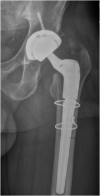The "Inside-Out" Anterior Osteotomy of the Proximal Femur via the Direct Anterior Approach in Revision Hip Arthroplasty
- PMID: 38205058
- PMCID: PMC10776325
- DOI: 10.1016/j.artd.2023.101219
The "Inside-Out" Anterior Osteotomy of the Proximal Femur via the Direct Anterior Approach in Revision Hip Arthroplasty
Abstract
Osteotomy techniques used for wide exposure during femoral component revision include the extended trochanteric osteotomy and its modifications. We describe an anterior proximal femur osteotomy technique starting from the inside of the femoral canal at the bone-implant interface and heading outward. The technique is used in conjunction with the extended direct anterior approach and allows direct access to and visualization of the anterior, medial, and lateral bone-implant interfaces. This technique is most useful for the removal of collared, fully hydroxyapatite-coated double-tapered femoral stems, in which bone-implant interfaces need to be accessed for removal of a well-osseointegrated hip arthroplasty implant.
Keywords: Direct anterior osteotomy; Femur osteotomy technique; Revision hip osteotomy.
© 2023 The Authors.
Figures











Similar articles
-
Femoral Bone Restoration Patterns in Revision Total Hip Arthroplasty Using Distally Fixed Modular Tapered Titanium Stems and an Extended Trochanteric Osteotomy Approach.J Arthroplasty. 2018 Jul;33(7):2210-2217. doi: 10.1016/j.arth.2018.02.065. Epub 2018 Feb 26. J Arthroplasty. 2018. PMID: 29599032
-
Removing Well-Fixed, Collared and Noncollared Tapered Hip Stems Without an Extended Trochanteric Osteotomy Using a Novel Stem Removal System.Arthroplast Today. 2021 Sep 9;11:146-150. doi: 10.1016/j.artd.2021.07.004. eCollection 2021 Oct. Arthroplast Today. 2021. PMID: 34541268 Free PMC article.
-
A Novel Technique for Femoral Stem Extraction Through the Direct Anterior Approach: The Medial Episiotomy With Anterior Transfemoral Osteotomy.Arthroplast Today. 2024 Dec 9;30:101583. doi: 10.1016/j.artd.2024.101583. eCollection 2024 Dec. Arthroplast Today. 2024. PMID: 39735211 Free PMC article.
-
Trochanteric osteotomies in revision total hip arthroplasty: contemporary techniques and results.Instr Course Lect. 2005;54:143-55. Instr Course Lect. 2005. PMID: 15948441 Review.
-
Trochanteric osteotomy and fixation during total hip arthroplasty.J Am Acad Orthop Surg. 2003 May-Jun;11(3):163-73. doi: 10.5435/00124635-200305000-00003. J Am Acad Orthop Surg. 2003. PMID: 12828446 Review.
Cited by
-
Modular Well-Fixed Hip Revision Stem Fracture: A Case Report and Literature Review.Arch Bone Jt Surg. 2024;12(10):735-741. doi: 10.22038/ABJS.2024.80313.3666. Arch Bone Jt Surg. 2024. PMID: 39478845 Free PMC article.
References
-
- Singh J.A., Yu S., Chen L., Cleveland J.D. Rates of total joint replacement in the United States: future projections to 2020-2040 using the National Inpatient Sample. J Rheumatol. 2019;46:1134. - PubMed
-
- American Joint Replacement Registry (AJRR): 2021 annual report. American Academy of Orthopaedic Surgeons (AAOS); Rosemont, IL: 2021.
LinkOut - more resources
Full Text Sources

